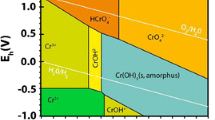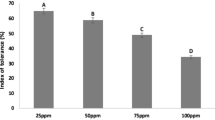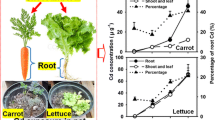Abstract.
Trivalent chromium (Cr3+) is essential for animal and human health, whereas hexavalent Cr (CrO4 2−) is a potent carcinogen and extremely toxic to animals and humans. Thus, the accumulated Cr in food plants may represent potential health hazards to animals and humans if the element is accumulated in the hexavalent form or in high concentrations. This study was conducted to determine the extent to which various vegetable crops absorb and accumulate Cr3+ and CrO4 2− into roots and shoots and to ascertain the different chemical forms of Cr in these tissues. Two greenhouse hydroponic experiments were performed using a recirculating-nutrient culture technique that allowed all plants to be equally supplied with Cr at all times. In the first experiment, 1 mg L−1 Cr was supplied to 11 vegetable plant species as Cr3+ or CrO4 2−, and the accumulation of Cr in roots and shoots was compared. The crops tested included cabbage (Brassica oleracea L. var. capitata L.), cauliflower (Brassica oleracea L. var. botrytis L.), celery (Apium graveolens L. var. dulce (Mill.) Pers.), chive (Allium schoenoprasum L.), collard (Brassica oleracea L. var. acephala DC.), garden pea (Pisum sativum L.), kale (Brassica oleracea L. var. acephala DC.), lettuce (Lactuca sativa L.), onion (Allium cepa L.), spinach (Spinacia oleracea L.), and strawberry (Fragaria × ananassaDuch.). In the second experiment, X-ray absorption spectroscopy (XAS) analysis on Cr in plant tissues was performed in roots and shoots of various vegetable plants treated with CrO4 2− at either 2 mg Cr L−1 for 7 d or 10 mg Cr L−1 for 2, 4 or 7 d. The crops used in this experiment included beet (Beta vulgaris L. var. crassa (Alef.) J. Helm), broccoli (Brassica oleracea L. var. Italica Plenck), cantaloupe (Cucumis melo L. gp. Cantalupensis), cucumber (Cucumis sativus L.), lettuce, radish (Raphanus sativus L.), spinach, tomato (Lycopersicon lycopersicum (L.) Karsten), and turnip (Brassica rapa L. var. rapifera Bailey). The XAS speciation analysis indicates that CrO4 2− is converted in the root to Cr3+ by all plants tested. Translocation of both Cr forms from roots to shoots was extremely limited and accumulation of Cr by roots was 100-fold higher than that by shoots, regardless of the Cr species supplied. Highest Cr concentrations were detected in members of the Brassicaceae family such as cauliflower, kale, and cabbage. Based on our observations and previous findings by other researchers, a hypothesis for the differential accumulation and identical translocation patterns of the two Cr ions is proposed.
Similar content being viewed by others
Author information
Authors and Affiliations
Additional information
Received: 27 February 1998 / Accepted: 2 April 1998
Rights and permissions
About this article
Cite this article
Zayed, A., Lytle, C., Qian, JH. et al. Chromium accumulation, translocation and chemical speciation in vegetable crops. Planta 206, 293–299 (1998). https://doi.org/10.1007/s004250050403
Issue Date:
DOI: https://doi.org/10.1007/s004250050403




